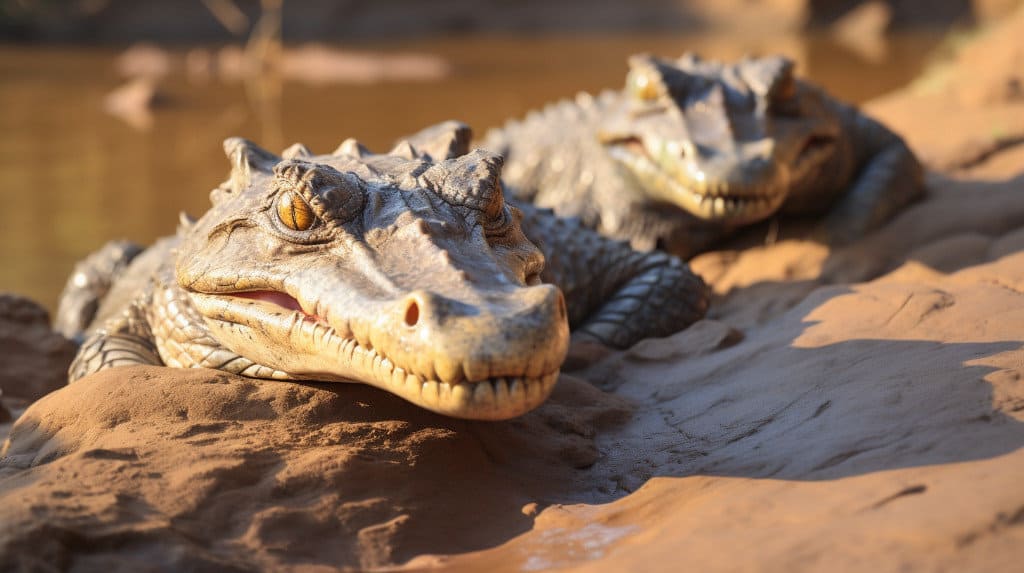Crocodiles, the fearsome reptiles that inhabit both land and water, have long been a subject of fascination for many. One question that often arises is whether these ancient creatures have ears. The answer is yes, crocodiles do have ears, but they are not quite like the ears we are familiar with. Instead of external ears that we can see, crocodiles have small openings on the sides of their heads that lead to their inner ears. These openings are covered by flaps of skin, which help protect the ears while the crocodile is submerged in water. Despite their unique ear structure, crocodiles have excellent hearing, allowing them to detect prey and potential threats in their environment.
Key Takeaways
| Fact | Information |
|---|---|
| Crocodiles have ears | Yes |
| Ear structure | Small openings on the sides of their heads |
| Ear protection | Covered by flaps of skin |
| Hearing ability | Excellent |
Understanding Crocodile Anatomy: Do Crocodiles Have Ears?

Crocodiles are fascinating creatures that have adapted to their environment in remarkable ways. One aspect of their anatomy that often sparks curiosity is their hearing ability. In this article, we will explore the existence of crocodile ears and their location within the reptile’s body.
The Existence of Crocodile Ears: Yes or No?
When it comes to reptile hearing, the presence of ears may not be as obvious as it is in mammals like us. While crocodiles do not have external ears like we do, they do possess hidden ears that allow them to perceive sounds in their surroundings. These ears are not visible from the outside, making them less noticeable compared to other animals.
Crocodiles have evolved to have a unique auditory system that enables them to detect vibrations and sounds both in the water and on land. This adaptation is crucial for their survival, as it helps them navigate their environment, locate prey, and communicate with other crocodiles.
The Location of Crocodile Ears
So, where exactly are these hidden ears located in crocodiles? The answer lies within their skulls. Crocodile ears are situated just behind their eyes, slightly below the surface of their skin. This placement allows them to remain protected while still being able to pick up on auditory cues.
To better understand the location of crocodile ears, let’s take a closer look at the anatomy of their skulls. The table below provides a brief overview:
| Crocodile Species | Ear Location |
|---|---|
| Saltwater Crocodile | Behind the eyes, slightly below the skin surface |
| Nile Crocodile | Behind the eyes, slightly below the skin surface |
| American Alligator | Behind the eyes, slightly below the skin surface |
| Indian Gharial | Behind the eyes, slightly below the skin surface |
As you can see, regardless of the crocodile species, their ears are consistently positioned in the same general area. This arrangement allows them to effectively capture sounds and vibrations from their surroundings, whether they are submerged in water or on land.
In conclusion, while crocodiles may not have visible external ears, they do possess hidden ears that play a crucial role in their sensory capabilities. These ears are located just behind their eyes, providing them with the ability to detect sounds and vibrations in their environment. This adaptation is essential for their survival and contributes to their remarkable behavior and biology.
So, the next time you encounter a crocodile, remember that even though you can’t see their ears, they are still equipped with an impressive auditory system that helps them thrive in their unique habitat.
Comparing Crocodiles and Alligators: A Look at Their Ears

Do Alligators Have Ears?
When it comes to the fascinating world of crocodile anatomy and reptile hearing, one might wonder if alligators have ears. The answer is yes, alligators do have ears, but they are not as visible as you might think. Unlike humans and many other animals, alligator ears are not located on the sides of their heads. Instead, they have hidden ears that are cleverly concealed.
Where are Alligator Ears Located?
To find an alligator‘s ears, you need to look closely at the sides of its head, just behind the eyes. Alligator ears are small openings covered by flaps of skin, which help protect them from water and debris. These flaps act as a barrier, allowing alligators to submerge themselves in water without worrying about damaging their delicate ears.
Do Alligators and Crocodiles Have Similar Ears?
While alligators and crocodiles belong to the same reptile family, their ears have some differences. Alligators have a more rounded ear opening, while crocodiles have a more elongated and slit-like ear opening. This distinction is one of the ways experts can tell the two species apart.
To further understand the differences, let’s take a look at a comparison table:
| Feature | Alligators | Crocodiles |
|---|---|---|
| Ear Shape | Rounded | Elongated |
| Ear Opening | Small | Slit-like |
| Location | Behind the eyes | Behind the eyes |
Despite these variations, both alligators and crocodiles have a remarkable auditory system that allows them to perceive sounds both above and below the water. Their ears are adapted to their semi-aquatic lifestyle, enabling them to navigate their environment and survive in their saltwater habitats.
In conclusion, while alligators and crocodiles may have different ear shapes and openings, they both possess the sensory organs necessary for hearing. These adaptations are just a small part of the incredible biology and sensory capabilities of these ancient reptiles.
So, the next time you encounter an alligator or a crocodile, remember that their hidden ears play a crucial role in their behavior and survival in their natural habitats.
The Functionality of Crocodile Ears
Crocodile ears play a crucial role in their survival and behavior. These reptiles have a unique auditory system that allows them to perceive sounds both in the air and underwater. Let’s explore the fascinating functionality of crocodile ears in more detail.
Do Crocodiles Have Good Hearing?
Crocodiles may not have the same level of hearing as some mammals, but they possess remarkable auditory capabilities that are perfectly adapted to their environment. These reptiles can hear a wide range of frequencies, including both low and high-pitched sounds. Their hearing is particularly acute in the water, where they spend a significant amount of time.
What Do Crocodile Ears Look Like?
Crocodile ears are not as visible as those of other animals. In fact, they are hidden behind flaps of skin located just behind their eyes. This unique adaptation helps protect their ears from water and other external elements while allowing them to hear effectively. The position of their ears also enables them to remain submerged while still being able to detect sounds from their surroundings.
Crocodile ear structure is designed to enhance their hearing abilities. They have a specialized middle ear that contains a series of bones called ossicles. These ossicles transmit sound vibrations from the eardrum to the inner ear, where they are processed and interpreted by the crocodile‘s brain.
Sensory Capabilities of Crocodiles
Crocodiles rely on their sensory organs, including their ears, to navigate their environment and locate prey. Their acute hearing helps them detect the movements and sounds made by potential prey, even when they are submerged in water. This sensory advantage allows crocodiles to ambush their prey with precision and efficiency.
Crocodile auditory system is also essential for communication and social interactions. These reptiles produce various vocalizations, including hisses, grunts, and bellows, which are used for territorial displays, courtship rituals, and warning signals.
In conclusion, crocodile ears may not be as visible as those of other animals, but they play a vital role in their survival and behavior. These hidden ears, combined with their unique auditory system, allow crocodiles to effectively perceive sounds both in the air and underwater. Their remarkable sensory capabilities contribute to their adaptability and success as apex predators in their environment.
Interesting Facts About Crocodiles

Crocodiles are fascinating creatures that have adapted to their environment in remarkable ways. Let’s explore some interesting facts about these ancient reptiles.
What Do Crocodiles Eat?
Crocodiles are apex predators and have a diverse diet. They are opportunistic feeders and will consume almost anything that comes their way. Their diet primarily consists of fish, birds, mammals, and reptiles. Some larger crocodile species, such as the saltwater crocodile, have been known to take down larger prey like wild boars, feral pigs, and even jaguars! These powerful reptiles have a strong bite force and sharp teeth that enable them to capture and devour their prey.
Why Do Crocodiles Keep Their Mouths Open?
Have you ever wondered why crocodiles often keep their mouths open? It’s not because they are yawning or trying to show off their teeth. In fact, there’s a fascinating reason behind this behavior. Crocodiles don’t have sweat glands like humans do, so they open their mouths to cool down. By keeping their mouths open, they release excess heat from their bodies, helping them regulate their temperature. Additionally, this behavior also helps them display their dominance and intimidate potential threats.
Crocodile anatomy plays a crucial role in their sensory capabilities. While they don’t have visible ears like humans, crocodiles have hidden ears located behind their eyes. These ears are covered by flaps of skin, allowing them to hear both in and out of the water. This unique adaptation enables crocodiles to detect vibrations and sounds, making them highly efficient hunters.
Crocodiles have a remarkable auditory system that allows them to perceive sounds both above and below the water’s surface. Their sensory organs are finely tuned to detect even the slightest movements or vibrations, helping them locate prey and navigate their surroundings. This adaptation is essential for their survival in their aquatic habitat.
In terms of crocodile biology, there are various species found across the world, each with its own unique characteristics. From the massive saltwater crocodile to the smaller Nile crocodile, these reptiles have adapted to thrive in different environments. Their size, teeth, and jaw strength vary depending on the species, but all crocodiles are formidable predators.
In conclusion, crocodiles are fascinating creatures with incredible adaptations and sensory capabilities. Their ability to survive and thrive in diverse environments is a testament to their evolutionary success. Whether it’s their powerful bite, hidden ears, or unique behaviors, crocodiles continue to captivate our curiosity and remind us of the wonders of the animal kingdom.
| LSI Keywords |
|---|
| Crocodile anatomy |
| Reptile hearing |
| Hidden ears in crocodiles |
| Crocodile sensory organs |
| Do reptiles have ears |
| Crocodile adaptations |
| Crocodile ear structure |
| How crocodiles hear |
| Underwater hearing in crocodiles |
| Crocodile behavior |
| Crocodile auditory system |
| Crocodile biology |
| Sensory capabilities of crocodiles |
| Crocodile species |
| Sound perception in reptiles |
Conclusion
In conclusion, crocodiles do have ears, although they may not be as visible as ours. These remarkable creatures have evolved to have small ear openings located on the sides of their heads, just behind their eyes. While their ears may not have external structures like pinnae, they are still equipped with a highly developed auditory system. Crocodiles use their ears to detect sounds and vibrations in the water, allowing them to locate prey, communicate with other crocodiles, and navigate their surroundings. Despite their fearsome reputation, crocodiles are fascinating creatures with unique adaptations, including their hidden ears.
Frequently Asked Questions
Does a crocodile have ears, yes or no?
Yes, crocodiles do have ears. However, they are not visible as they are covered by flaps that open when the crocodile surfaces.
Do crocodiles have external ears?
No, crocodiles do not have external ears like humans. Their ears are located behind their eyes and are covered by a protective flap of skin.
What does a crocodile’s ear look like?
A crocodile’s ear is not easily visible. It’s located behind their eyes and covered by a flap of skin which can be opened and closed. The ear opening is a narrow vertical slit.
Do crocodiles have good hearing?
Yes, crocodiles have excellent hearing. They can hear both above and below water, which assists them in locating prey and perceiving threats.
Where are a crocodile’s ears located?
A crocodile’s ears are located behind their eyes. They are covered by a protective flap of skin which can be opened and closed.
Do alligators and crocodiles have ears?
Yes, both alligators and crocodiles have ears. They are hidden behind flaps of skin to protect them while the reptiles are underwater.
Do alligators have ears?
Yes, alligators do have ears. Similar to crocodiles, their ears are hidden and located behind their eyes.
How do crocodiles hear underwater?
Crocodiles have a special adaptation that allows them to close their ear flaps when they go underwater, protecting the ear canal. Yet, they can still perceive vibrations and sounds underwater.
How are a crocodile’s auditory system and sensory capabilities adapted for its environment?
Crocodiles have evolved to have a hidden ear structure that can be closed off while they are underwater. This, along with their excellent underwater hearing capabilities, allows them to detect prey and threats effectively.
What are some unique aspects of crocodile biology and anatomy, particularly in relation to their hearing?
Crocodiles have a unique anatomy allowing them to hear underwater. Their ears are located behind their eyes and covered by a flap of skin. They have evolved to have excellent hearing capabilities, both above and below water, which is crucial for their survival.




